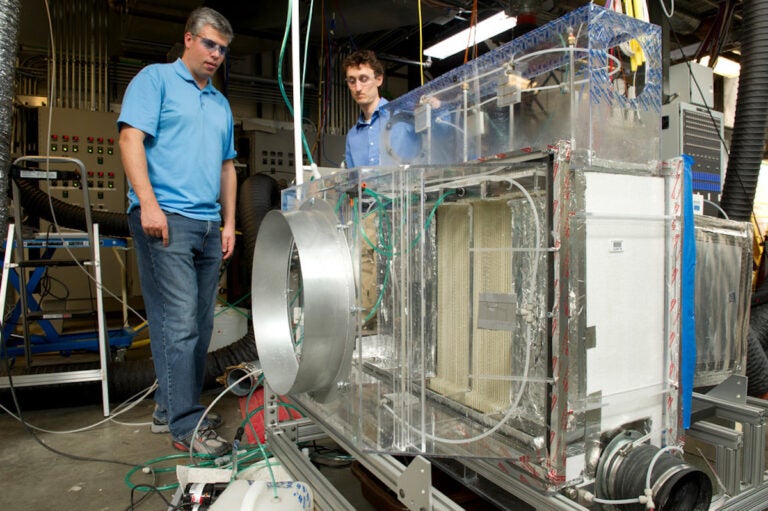Meet two companies vying to make the next generation air conditioner
Air conditioning is a century-old technology, but now companies are racing to reinvent it and lower its large environmental footprint.
Listen 11:45
NREL engineers Eric Kozubal, left, and Jason Woods conduct initial research on the Blue Frontier prototype, the first sustainable HVAC system capable of reducing CO2 emissions by 85%. (Photo by Dennis Schroeder/NREL 20175)
This story is from The Pulse, a weekly health and science podcast.
Find it on Apple Podcasts, Spotify, or wherever you get your podcasts.
Engineer Sorin Grama got interested in air conditioning when he was living in India and working on a project to improve the milk supply chain.
One of his colleagues complained that her daughter could not focus on her studies for school because it was too hot. Grama gave her an extra air conditioner he had lying around.
“When I saw her again. I was very excited to see what difference it made. So I was asked, ‘How is it going?’” He said. “She looked at me very sheepishly and she said, ‘We’re not using it because it’s too expensive to run.'”
That got him interested in improving the 100-year-old technology to make a more efficient air conditioner. He said the problem is that air conditioners dry the air and cool the air at the same time.
“It does this … in a very inefficient, brute-method way — basically over cooling the air in order to draw the moisture out of it.”
Air conditioners cool the air so much that moisture becomes a liquid, but that makes it too cold, so it heats the air back up again. That is also why all air conditioners drip water.
Cooling a warming world
The environmental footprint of air conditioning is a big problem that continues to grow.
The world has an estimated 2 billion air conditioners already, according to the International Energy Agency. Air conditioners and fans account for roughly 20% of electricity used in buildings, according to a 2018 report from the IEA. Air conditioners not only use a lot of electricity, but have a large carbon footprint, and the industry estimates global demand is rising, especially in developing countries where fewer households already have air conditioning.
Now several companies are making next generation air conditioners that are designed to be more efficient and have a small environmental footprint.
Subscribe to The Pulse
Grama’s company, Transaera, made an air conditioner that has a type of material called a metal organic framework, which is very good at absorbing moisture from the air. One of his colleagues once described it as “sponges on steroids.”
This special material removes water from the air, and thus the air conditioner does not need to cool the air to an uncomfortably cold temperature. Grama said this could save 40-50% of the energy used by a traditional air conditioner.
“This can transform the way air conditioning is done,” Grama said.
The air conditioner is about the size of a small car, and is shaped like either the state of Tennessee, or a Star Wars sand crawler, said Mike Strauch, product engineering manager.
The company recently tested their hand-built air conditioner at a lab in Maryland, which can simulate different outside temperatures and conditions for what a building full of people would do to change the air that comes out. They say the tests show their unit is far more efficient than the government-required efficiency standard for a device of its kind, and is more efficient than products from direct competitors.
This first unit is meant for industrial uses like a warehouse, but Grama said the technology could be used for homes or even cars. The plan is to have a commercial product ready by next summer. They have millions of dollars in startup funding, including support from Carrier, the company widely credited with inventing modern air conditioning more than a century ago.
Reducing ‘the most annoying load’
Another problem with current generation air conditioners is that they use energy at a bad time, said engineer Daniel Betts, who used to work at energy companies.
“Air conditioning was … the most annoying load, meaning that air conditioners turned on at the wrong time,” Betts said.
He explained that equipment for generating and transmitting electricity does not function as well when it is hot outside, which is precisely when most people turn on air conditioners. He heard about a solution from the National Renewable Energy Laboratory 10 years ago, and he helped launch a company, Blue Frontier, based on that technology.
It works partly like an evaporative cooler or swamp cooler, which cools a room by using a fan to send air across a wet surface. The water evaporating from the surface takes some of the heat energy, thus cooling the room, the same principle behind sweating.
Swamp coolers only work in dry climates because the process also makes the room more humid. Blue Frontier’s air conditioner creates the very dry climate by using a liquid that absorbs water from the air to create a “desert like condition,” explained Betts.
“However, I have another trick up my sleeve that a conventional swamp cooler does not have,” he said.
The Blue Frontier air conditioner can also use electricity to dry out the liquid that absorbs the water, and it can do this at night when there is not as much demand for electricity.
“Then the air conditioner becomes sort of like a battery,” said Betts.
Blue Frontier also has millions in start up funding. They are testing some pilot units in buildings, but hope to have a larger release next year.
Growing demand means ‘a huge opportunity and a huge urgency’
There are even more companies working on better air conditioners, from startups to traditional air conditioner manufacturers, said Ankit Kalanki, who specializes in energy efficiency and cooling at RMI, a clean energy nonprofit.
“There is a lot of … excitement in the cooling sector right now.”
But he added that these products will be more expensive in the beginning, and most likely will not be units for homes. Companies need to know there is a market for this technology before they make a lot of them.
In the meantime, there are ways to use existing technology and parts to make air conditioners more efficient, said Nihar Shah, who directs the global cooling efficiency program at Lawrence Berkeley National Lab.
“It’s not … rocket science. It was more like taking what’s already available, and figuring out where the cost cutting could happen, and then redesigning the equipment so that we use the least cost components to come up with better efficiency.”
He said they have four prototypes like this, and plan to release a report on their findings soon, so air conditioner companies can consider putting their ideas into new models.
It is important to make newer, more efficient air conditioners, because while developed countries like the U.S. already have many households with air conditioners, this is not the case for developing countries, said Kalanki.
“People’s income is increasing, especially in the emerging economies,” he said. And as temperatures continue to rise, Kalanki said, one of the first things people will buy is an air conditioner.
“(This) represents a huge opportunity and a huge urgency for us to solve this problem.”
WHYY is your source for fact-based, in-depth journalism and information. As a nonprofit organization, we rely on financial support from readers like you. Please give today.







